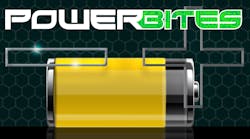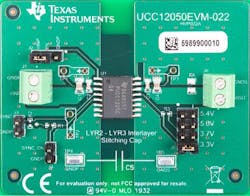How did TI manage to shoehorn an isolation transformer into its new dc-dc supply chips? Will MIT's process for creating pure lithium anodes enable quantum leaps in Li-ion battery capacity and longevity? Can STMicro's new automotive development platform really automate most of the details involved with creating custom ECUs? What new applications will MagnaChip's automotive-certified 0.13-micron process enable by making it possible to fabricate bipolar, CMOS, and DMOS on a single chip?
The answers for these and other pressing questions can be found in our debut edition of PowerBites, helmed by electronics industry veteran Lee Goldberg.
TI's Isolated Power Supplies Feature Compact Footprint, Industry-Leading EMI
Texas Instruments has introduced the first in a series of high-efficiency isolated dc-dc converters that use an integrated isolation transformer to achieve what they believe to be the industry’s lowest electromagnetic-interference (EMI) levels. TI's UCC12050 can deliver up to 500 mW of isolated 5.0- or 3.3-V output power at 60% efficiency (Fig. 1). Built for industrial and medical requirements, the UCC12050’s 5-kVrms reinforced isolation and 1.2-kVrms working voltage protects industrial transport, grid infrastructure, and medical equipment against high-voltage spikes without any additional components.
To achieve high performance and reduce component count, the converter's transformer and its companion EMI shield are integrated into the device's package along with the chip. By integrating a complete isolated dc-dc solution into a 16-pin small-outline integrated circuit (SOIC) package measuring 10.3 × 10.3 × 2.65 mm, a converter based on the UCC12050 requires up to 80% less PCB space than a conventional solution. TI also offers the UCC12040, a lower-cost device intended for less-demanding applications, which provides all of '2050's features and basic isolation (3 kVrms).
The UCC12050 and UCC12040 are available in volume production from TI and authorized distributors. Pricing starts at US$3.90 and US$3.15, respectively, in 1,000-unit quantities. Engineers can evaluate this product with the UCC12050EVM-022 evaluation module, which goes for US$99.
MagnaChip's 0.13-µm BCD Process Targets Automotive Power Apps
Korea-based MagnaChip Semiconductor Corp. announced today that it added an enhanced-performance, 0.13-µm bipolar-CMOS-DMOS (BCD) process to its portfolio of foundry processes intended to help automotive power-semiconductor designers build more competitive products. The BCD process technology combines three different process technologies onto a single chip: CMOS for digital functions, bipolar for analog signal control, and DMOS high-power functions, such as motor drivers and actuators. It supports an IP for an electrically erasable programmable ROM (EEPROM), which can be reprogrammed at least 1000 times.
The process has been certified as Grade-1 under the AEC-Q100 automotive reliability standard, making it suitable for manufacturing many types of automotive power devices, including motor-driver ICs, battery-management systems (BMSs) and dc-dc converters.
For more information, visit www.magnachip.com.
STMicro's New Development Tools Simplify Prototyping of Automotive ECUs
The latest version of its AutoDevKit ecosystem developed by STMicroelectronics includes tools that assist the development of electronic control units (ECUs). ECUs manage the numerous the growing number of motors, actuators, and other components found in modern electric and conventional vehicles. Available for free, the AutoDevKit library is a software environment that lets users select the microcontrollers and functional boards from ST’s wide automotive portfolio. Once configured, the AutoDev platform guides users to connect the boards, generate code, and compile and download firmware, without forgetting prototype testing and debugging.
Also included within the AutoDevKit ecosystem are AEKD System Solution Demonstrator components that provide direct access to pre-assembled system-demonstrator boards. Furthermore, board kits and non-electronic hardware assemblies such as car-like components and loads can help users closely emulate the desired solution.
Further information and free downloads can be found at http://www.st.com/autodevkit.
MIT's New Electrode May Lead to More Powerful, Longer-Lifetime Lithium Batteries
New research by engineers at MIT and elsewhere could lead to batteries that pack more power per pound and last longer, based on the long-sought goal of using pure lithium metal as the battery’s anode. The design is part of a concept for developing safe all-solid-state batteries, which don't require the liquid or polymer gel often currently used as the electrolyte material between the battery’s two electrodes.
An electrolyte allows lithium ions to travel back and forth during the charging and discharging cycles of the battery. An all-solid version could be safer than liquid electrolytes, which have high volatility and have been the source of explosions in lithium batteries.
The concept for the new electrode comes from the laboratory of Ju Li, the Battelle Energy Alliance Professor of Nuclear Science and Engineering and professor of materials science and engineering. It’s described in the journal Nature, in a paper co-authored by Yuming Chen and Ziqiang Wang at MIT, along with 11 others at MIT and in Hong Kong, Florida, and Texas.
“There has been a lot of work on solid-state batteries, with lithium metal electrodes and solid electrolytes,” says Li, but these efforts have faced a number of issues.
One of the biggest problems is that when the battery is charged up, atoms accumulate inside the lithium metal, causing it to expand. The metal then shrinks again during discharge, as the battery is used. These repeated changes in the metal’s dimensions, somewhat like the process of inhaling and exhaling, make it difficult for the solids to maintain constant contact. Subsequently, it tends to cause the solid electrolyte to fracture or detach.
To overcome this, Li and his team adopted an unusual design that utilizes two additional classes of solids—“mixed ionic-electronic conductors” (MIEC) and “electron and Li-ion insulators” (ELI), which are absolutely chemically stable in contact with lithium metal. They then developed a three-dimensional nanoarchitecture in the form of a honeycomb-like array of hexagonal MIEC tubes, partially infused with the solid lithium metal to form one electrode of the battery, but with extra space left inside each tube (Fig. 2).
When the lithium expands in the charging process, it flows into the empty space in the interior of the tubes, moving like a liquid, even though it retains its solid crystalline structure. This flow, entirely confined inside the honeycomb structure, relieves the pressure from the expansion caused by charging, but without changing the electrode’s outer dimensions or the boundary between the electrode and electrolyte.
Additional details can be found in the complete story, available at: https://news.mit.edu/2020/solid-batteries-lithium-metal-electrode-0203.
Renesas’ Rad-Hard Dual-Output Buck Converter + LDO Targets Civilian, Mil-Space Apps
The ISL70005SEH is a rad-hard single-chip synchronous buck and low-dropout (LDO) regulator intended for spaceflight payload applications, such as low-power FPGAs, DDR memory, and other digital loads. By integrating a 95% efficient synch buck regulator and an LDO, Renesas’ rad-hard point-of-load power solution reduces size, weight, and power (SWaP). It also simplifies the assembly and component count of the electronics used in medium-Earth-orbit (MEO) and geosynchronous-Earth-orbit (GEO) long-duration missions. Key features include:
- Synchronous buck VIN range of 3 to 5.5 V
- LDO VIN range of 600 mV + VDO to VCC-1.5 V
- 1% reference-voltage accuracy
- Separate VIN, enable, soft-start, and power good indicator
- LDO stable with 150 µF; 3X less output capacitance than competitive solutions
- Full military temperature range of −55 to +150°C
- Wafer acceptance tested to 100 krad(Si) over high dose rate
- Tested for ELDRS up to 75 krad(Si) over low dose rate
The ISL70005SEH radiation-hardened dual-output PoL regulator is available now in a 28-lead ceramic dual flatpack package or in die form. An evaluation board also is available to evaluate device features and performance. For more information, visit: www.renesas.com/products/ISL70005SEH.




